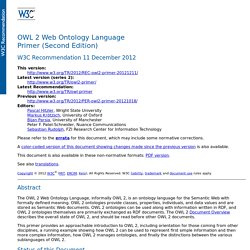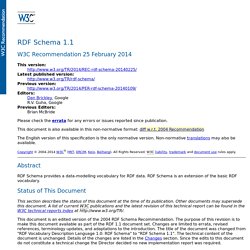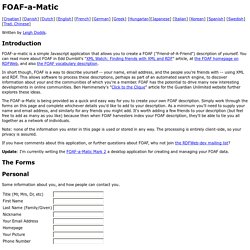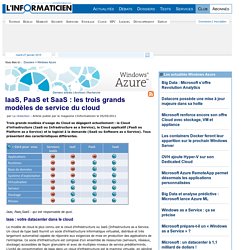

M2 MBDS - Hadoop / Big Data. OWL 2 Web Ontology Language Primer (Second Edition) W3C Recommendation 11 December 2012 This version: Latest version (series 2): Latest Recommendation: Previous version: Editors: Pascal Hitzler, Wright State University Markus Krötzsch, University of Oxford Bijan Parsia, University of Manchester Peter F.

Sebastian Rudolph, FZI Research Center for Information Technology Please refer to the errata for this document, which may include some normative corrections. A color-coded version of this document showing changes made since the previous version is also available. This document is also available in these non-normative formats: PDF version.
See also translations. Copyright © 2012 W3C® (MIT, ERCIM, Keio), All Rights Reserved. Abstract The OWL 2 Web Ontology Language, informally OWL 2, is an ontology language for the Semantic Web with formally defined meaning. Status of this Document May Be Superseded This section describes the status of this document at the time of its publication. Summary of Changes Please Send Comments. RDF Schema 1.1. Abstract RDF Schema provides a data-modelling vocabulary for RDF data.

RDF Schema is an extension of the basic RDF vocabulary. Status of This Document This section describes the status of this document at the time of its publication. Protégé. Habilitation à Diriger les Recherches (HDR) Fabien Gandon - Graphes RDF et leur Manipulation pour la Gestion de Connaissances. Graphes RDF et leur Manipulation pour la Gestion de Connaissances.

Mémoire d’Habilitation à Diriger les Recherches soutenue le Mercredi 5 novembre 2008 par Fabien L. Gandon devant un jury composé de · Président : Pierre Bernhard · Rapporteur : Nathalie Aussenac-Gilles · Rapporteur : Marie-Laure Mugnier · Rapporteur : Vincent Quint · Examinateur : Bertrand Braunschweig. An introduction to Semantic Web and Linked Data. Données liées et Web sémantique : quand le lien fait sens. RDF Translator. Flint SPARQL Editor Demo. Welcome to Flint, our editor for SPARQL queries.

Features Flint 1.0 is now available. This is our first production release. This version supersedes Flint 0.5.1 which was released June 2011. Flint has the following features: Flint should work in Firefox, Chrome, Safari and Opera. Getting the Code Flint has been released with an open license for deployment on your own site. Feedback If you have comments, suggestions or bug reports please send them to flintsparqleditor@tso.co.uk.
Describe yourself in RDF. Written by Leigh Dodds.

Introduction FOAF-a-matic is a simple Javascript application that allows you to create a FOAF ("Friend-of-A-Friend") description of yourself. You can read more about FOAF in Edd Dumbill's "XML Watch: Finding friends with XML and RDF" article, at the FOAF homepage on RDFWeb, and also the FOAF vocabulary description. In short though, FOAF is a way to describe yourself -- your name, email address, and the people you're friends with -- using XML and RDF. This allows software to process these descriptions, perhaps as part of an automated search engine, to discover information about your and the communities of which you're a member.
The FOAF-a-Matic is being provided as a quick and easy way for you to create your own FOAF description. Note: none of the information you enter in this page is used or stored in any way. If you have comments about this application, or further questions about FOAF, why not join the RDFWeb-dev mailing list? People You Know Generate Results License. Présentation "Manifeste de Chris Date sur modèle « Objet Relationnel » (pour données structurées/SQL) Professeur Serge Miranda serge.miranda Directeur Master."
In-Memory Database, NewSQL & Real-Time Analytics. IaaS, PaaS et SaaS : les trois grands modèles de service du cloud > www.linformaticien.com : Actualités informatique, Réseau, Sécurité, Technologie, Développement. Trois grands modèles d’usage du Cloud se dégagent actuellement : le Cloud d’infrastructure (IaaS ou Infrastructure as a Service), le Cloud applicatif (PaaS ou Platform as a Service) et le logiciel à la demande (SaaS ou Software as a Service).

Tous présentent des caractéristiques différentes. Iaas, Paas,SaaS : qui est responsable de quoi. Iaas : votre datacenter dans le cloud Le modèle de cloud le plus connu est le cloud d’infrastructure ou IaaS (Infrastructure as a Service. Un cloud de type IaaS fournit un socle d’infrastructure informatique virtualisé, distribué et très largement automatisé capable de répondre aux exigences de mise en production des applications de l’entreprise.